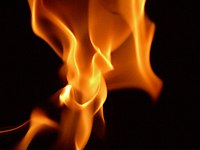
Photo from wikipedia
Abstract Low temperature combustion of n-heptane was investigated through an experimental and numerical study of laminar cool flame structure and propagation speeds. Lean and stoichiometric n-heptane cool flames of equivalence… Click to show full abstract
Abstract Low temperature combustion of n-heptane was investigated through an experimental and numerical study of laminar cool flame structure and propagation speeds. Lean and stoichiometric n-heptane cool flames of equivalence ratios 0.4–1.0 were stabilized using a Hencken burner at sub-atmospheric pressures. Characterization of cool flame lift-off heights in burner-stabilized and freely propagating regimes was performed using broadband chemiluminescence and formaldehyde planar laser-induced fluorescence (CH2O PLIF), and the adiabatic cool flame propagation speed was estimated at the intersection of these two regimes. Temperature measurements of cool flames were performed and temperature profiles were employed in fixed temperature numerical simulations. Reduction of a chemical kinetics model was conducted using the Directed Relation Graph method along with reaction rate sensitivity analysis, and a reduced model covering the range of experimentally investigated equivalence ratios was achieved. The resultant propagation speeds from freely propagating flame simulations using the reduced model were compared with experimentally measured values. Additionally, CH2O PLIF intensity profiles over a range of reactant flow rates were compared to assess flame structures in freely propagating and burner-stabilized regimes. Finally, mole concentrations of major species at quasi-equilibrium conditions downstream of the flame were compared to numerical simulations using the full and reduced models, and reasonable agreement between the experiments and simulations was observed.
Journal Title: Combustion and Flame
Year Published: 2019
Link to full text (if available)
Share on Social Media: Sign Up to like & get
recommendations!